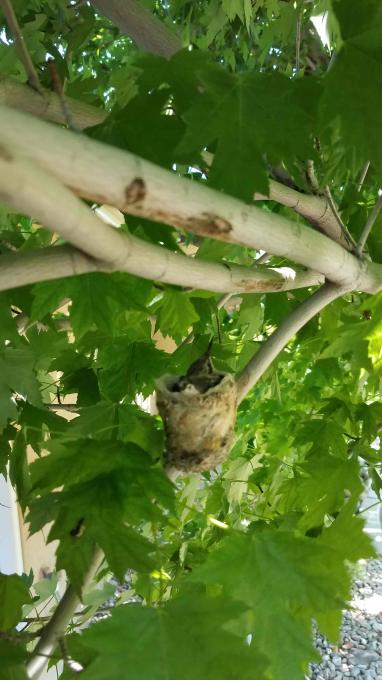Donita
Forum Replies Created
-
DonitaParticipantI wonder about the temperature of the sugar water too. I try to put it out at room temp but in the summer heat, even in the shade, I know it's getting pretty warm. I do change much more often in the heat.in reply to: How Hummingbirds Rule the Nectar World #975896
-
DonitaParticipantYes, you have your own beautiful and unique species which we never see in N. America.in reply to: How Hummingbirds Rule the Nectar World #975894
-
DonitaParticipantI suspect that more people are interested in the incredible studies going on these days and that helps funding. Back in the 70s people still thought studying animal behavior was useless and nonsense!in reply to: How Hummingbirds Rule the Nectar World #975893
-
DonitaParticipantThe structure of the wings are so different from other birds and how their tongues work! I also didn't know they perched so much of the time. I have sugar water and flowers for them in the backyard but from my office window in the front of the house I see them come by the flowerless shrubs and suspect they are going after bugs.in reply to: How Hummingbirds Rule the Nectar World #975890
-
DonitaParticipantNo Rufus around you? I get them on their fall migration for a couple weeks and can't wait for them to leave. Talk about aggression, it's hard to believe they would let any close enough to even mate!in reply to: Life of a Hummingbird #974771
-
DonitaParticipantThe biggest difference is their independence & territorialism. My other avian visitors take turns (mostly) at the feeders but these little buggers can't seem to do it! The only time I have more than one at a feeder is the newly fledged till they realize they shouldn't be sharing! There are lots of raptors in the area which may be seen out alone but I know they go back to their mates and young ones. I can't think of any similarities besides drinking the same sugar water as the Bullock's Orioles.in reply to: Life of a Hummingbird #974768
-
DonitaParticipantI have had Rufous, Black-chinned, and once a Broadtail visit in the mountains at 6000' in SW Utah. Black-chinned from spring till fall, Rufus on their way back south in the fall. They are fun to see but they take over and soon I'm wanting them to move on and leave my Black-chinned alone! So far no mention of the Black-chinned in the video but from something I read is that it is actually a hybrid. I finally found a nest which I visited a few times then the last time I watched it fledge!
 in reply to: What Makes a Hummingbird a Hummingbird #974762
in reply to: What Makes a Hummingbird a Hummingbird #974762 -
DonitaParticipantYou can try watercolor pencils. There are some cheap beginner sets so that you can get a feel for them with out a big investment. You can use them as colored pencils or as watercolors. Sometimes I use them as watercolors then at textures/details as just colored pencils. They are fun to experiment with and YouTube videos to help you get started.in reply to: Best drawing tools #965766
-
DonitaParticipantFor me they feed on nyjer in the winter but ignore it the rest of the year. They are into the sunflower all year. My goldfinches & lesser goldfinches take off during summer. I haven't seen any in the last couple weeks but have so many I can't count in the winter!in reply to: Finches Not at Feeder #965765
-
DonitaParticipantThe Country Diary of an Edwardian Lady is a beautiful book! I see Amazon has a coloring book which might be fun.in reply to: The Power of Reflection #963841
-
DonitaParticipantBeautiful job on the Baltimore! I have Bullock's around here. Such striking birds!in reply to: The Power of Reflection #963831
-
DonitaParticipantYour goldfinch is awesome!in reply to: Noticing Themes in Nature #963025
-
DonitaParticipantI wouldn't feed anything with mold to the birds.in reply to: need information on feeding birds please!! #960983
-
DonitaParticipantI see it on the right at the end. Haven't a clue what it is.in reply to: Can you spot the OTHER bird in this picture? #960982
-
DonitaParticipantIt's been awhile since I lived in an urban environment and I wasn't much into birds. But what I do remember is seeing and laughing at the crows and ravens eating at dumpsters around eating establishments. I saw them with the little plastic ketchup cups, picking at pizza boxes and left over food containers. People seemed to just ignore them.in reply to: Consequences of Urban Life #960166
-
DonitaParticipant1. They all seem healthy to me. I haven't noticed (or looked for) and foot missing. I don't know how the virus effected my current area. I wasn't living here at the time. 2. No aggression noticed between them, just harrassing other raptors.in reply to: A Real Murder of Crows #960055
-
DonitaParticipant1. When it comes to inbreeding, are these unwilling females? I'm sure some are unknowing inbreeding too. 2. Extra-pair fertilization is not surprising to me in any species of animal. It can be beneficial to bring in new strong traits but also go the other way and introduce a weakness. But I can see that it can also lead to unknowing inbreeding.in reply to: Secret Sex Lives #960040
-
DonitaParticipantThey seem to have more choices than alot of other species and always seem to find a home someplace. Since they can live in just about any environment and have a wide range of diet that finding a new territory shouldn't be too much of a problem. So I would think it would be easier to be a breeder.in reply to: Routes to Breeding Status #960037
-
DonitaParticipantI've had large flocks of waxwings come in during fall migration. They land on the trees and strip off all the fruits then take off. Starlings have done it too.in reply to: Life in a Flock #959832
